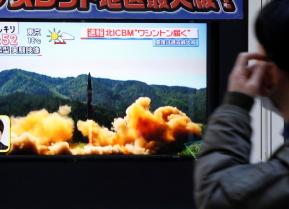Why America Should Fear Russia's New Avangard Hypersonic Weapon: "We Don't Have Any Defense"
Is the U.S. falling behind Russia and China in hypersonic weapons development?
Russian President Vladimir Putin’s March 1, 2018 annual annual state-of-the-nation address became his most-cited since his 2007 Munich speech. “Listen to us now,” he warned NATO after unveiling several hypersonic, nuclear-capable weapons: the Kinzhal missile system, Sarmat ICBM, and the Avangard glide vehicle.
The March 1st adress fell under a similar criticism: the Kremlin is bluffing, signaling capabilities that it doesn’t have to drive NATO to the negotiating table on terms favorable to Russia. But subsequent developments have borne out an altogether different truth: these weapons are, in fact, quite real, and pose varying levels of strategic threat.
The latest confirmation of Russia’s hypersonic weapons development progress came earlier today, when President Putin announced that the Avangard system had been successfully tested: "On my instructions the industrial enterprises and the Defense Ministry have prepared for and carried out the final test of this system… the test was completely successful: all technical parameters were verified," he said to his cabinet.
Putin added that Avangard is on the verge of deployment readiness: "Starting from next year, in 2019, a new intercontinental strategic system Avangard will enter service in the Russian army and the first regiment in the Strategic Missile Troops will be deployed."
Avangard, also known as “Objekt 4202,” is a hypersonic boost-glide missile system that is supposed to combine a high-performance ballistic missile with an unmanned glider vehicle for significant improvements in maneuverability and sustained top speed. This technology allows Avangard missiles to travel at up to 20 Mach or approximately 24,700 km per hour, a speed made possible by the use of “new composite materials” to stay within a stable range of 1,600 to 2,000 degrees celsius.
This design translates into a missile that is not only more difficult, but impossible to intercept according to Putin: “The Avangard is invulnerable to intercept by any existing and prospective missile defense means of the potential adversary.” The Russian president adds that this is due to the extreme agility made possible by its boost-glider, enabling “lateral” and “vertical” evasive maneuvers by “several thousand kilometers.”
As it stands, U.S. military experts offer a grim assessment of America’s ability to intercept such a missile: “We don’t have any defense that could deny the employment of such a weapon against us,” said US Air Force General John E. Hyten, the Commander of US Strategic Command. It should be noted that, for a weapon with potential capabilities as devastating as the nuclear-capable Avangard system, even a relatively optimistic interception rate of, say, 50% still would pose an unacceptable risk.
A 2019 deployment schedule would put Russia ahead of China and the U.S. in the hypersonic, nuclear-capable boost-glider arms race. China’s hypersonic glider analogue to Avangard, the DF-ZF, is still in testing and appears to be on track for a 2020 release. Less is known of concrete American production plans, with some experts suggesting that that US research is driven by different objectives in non-nuclear hypersonic boost-glide system research.
Russia’s focus on advanced, nuclear-capable hypersonic weapons with purported first-strike capability like Avangard reflects a particular-kind of strategic thinking: researching, developing, and manufacturing a few un-interceptable nuclear warheads that can be more cost-effective over the long term than trying to match NATO’s combined output of conventional strategic weapons.
Mark Episkopos is a frequent contributor toThe National Interest and serves as research assistant at the Center for the National Interest. Mark is also a PhD student in History at American University


